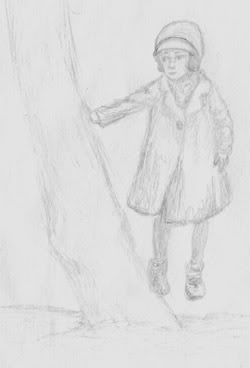(A small glossary is at the end of the post, in case some terms are unfamiliar.)By watching plenty of subtitled anime and doramas, and reading plenty of scanlated manga, I have inevitably picked up some of the language. As my familiarity with Japanese has increased, my interest in learning it properly has grown, to the point that -- spurred in part by wanting to know what happens next in
Skip Beat -- I decided to take action.
Accordingly, about two months ago, I went to the library and borrowed three books: an English textbook, a German textbook, and a kanji and kana workbook. With their help, I learned hiragana and katakana, as well as some basic vocabulary and grammar.
The trouble with library books, though, is that one can't keep them indefinitely, nor can one write in them. So, a few days ago, I went to Lehmanns and Hugendubel to buy some books of my own. My first purchase was Langenscheidt's
Kanji und Kana 1, which has all the Jōyō kanji, along with their readings, definitions, penji, etc. I also bought a small Japanese-German/German-Japanese dictionary -- the mini 4" by 3" plastic-cover kind that normally brings out the snob in me. Personally, I much prefer large hardcover dictionaries (perhaps in multiple volumes), with plenty of definitions, examples, remarks about usage, and so on. Unfortunately, those tend to be considerably more expensive, and I'm unlikely to be needing a Japanese dictionary like that any time soon.
Anyway, having bought the two dictionaries, I was still in need of a textbook. I found it surprisingly difficult to find one that suited my preferences. I wanted a simple, relatively compact textbook centred around grammar, rather than one with fancy graphics and "a trip to the supermarket" sort of chapters. In the end, I settled for a second-hand book from the Bücherhalle next door. In truth, it is far from ideal (perhaps worse than the other textbooks I was considering). The biggest drawback is that the Japanese is all romanized; there is no kanji or kana in the book. Moreover, the textbook uses
kunrei-shiki romanization rather than Hepburn romanization -- not necessarily a bad thing, but it is a bit strange to come across spellings like "zyuusiti," "zitu," and "syatyoo."
Still, the textbook is probably fine for learning grammar and some vocabulary. Besides, it was cheap (only 5 Euros) and there are some interesting conversations in the back, which should be fun to read even if they are rather outdated. "Outdated," incidentally, because the book is from 1958. I find the book's age charming in itself, but it is probably an additional disadvantage in most respects.
Here, by the way, is the preface:
Japan is a country with a long cultural tradition. Her works of art are famous throughout the world. She is also one of the leading industrial and trading nations, with a population of over eighty millions increasing by a million a year. Thus many people in the world are in contact with some aspect or other of her activity; yet outside of Japan and her former Empire, and those parts of North and South America where many Japanese have settled her language is known by only a few hundred people at the most. Without a wider knowledge of her language, appreciation of her rich culture must remain restricted. Business-men, too, would find great advantage in becoming familiar with Japanese, not only in their negotiations but also in the key it provides to the way the Japanese think.
The publishers and authors have collaborated with the Linguaphone Institute Ltd., 207, Regent Street, London, W.I., in producing a course of ten gramophone records using material from this book.
The authors wish to acknowledge their debt to Mr. F. J. Daniels, Reader in Japanese in the University of London, for the helpful criticism he has given them in the course of the preparation of the book, and for allowing them to use certain materials prepared by him for teaching Japanese at the School of Oriental and African Studies.
I particularly like the use of "she" and "her" when referring to Japan and the gramophone records bit. Unfortunately, the records didn't come with the book. I would have dearly liked to hear the conversations at the back of the book read out by people from the '50s.
Well, when my brother comes back from his visit to our uncle and aunt, I'll see whether he is willing to order Langenscheidt's
Praktischer Sprachlehrgang and perhaps
New Intensive Japanese for me. The second is the English textbook that I borrowed from the library, and the first is similar to the German textbook I borrowed (only with cassettes).
In the meantime, I'll start working through the 1958 textbook, while learning relevant kanji from the Kanji and Kana book. Maybe the other textbooks won't be necessary.
One last matter: I recently installed an input method editor on one of our computers so that I can type in Japanese. I've seen people type or text-message in anime, and it's fun to try it myself, even if the procedure is slightly different. In my case, I enter latin characters, which turn to hiragana, which can then be turned into katakana or various kanji as applicable.
anime: Japanese animated TV series
doramas: Japanese TV dramas
manga scanlations: (also "scanslations") unofficial translated versions of Japanese comics or graphic novels
kanji: refers to many thousands of (often complex) characters based on Chinese characters; used mostly for nouns, adjective stems, and verb stems
kana: refers to hiragana and katakana, the two Japanese syllabaries
hiragana: rounded syllabary; forty-six characters, each representing a syllable; is used for most things not already covered by kanji
katakana: square syllabary (also forty-six characters); corresponds to hiragana, but is used differently (e.g. to write foreign words and for emphasis)
Jōyō kanji: an official list of kanji that one is expected to know by the time one graduates from secondary school
penji: handwritten kanji and kana (written with a pen or pencil rather than a brush)
kunrei-shiki romanization: adheres to Japanese phonology, and clearly shows patterns (e.g. in grammar)
Hepburn romanization: adheres to English phonology, so that pronunciation is straightforward



